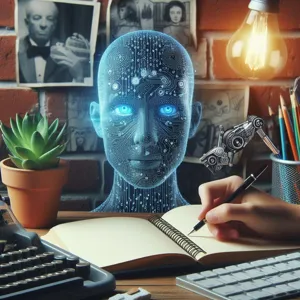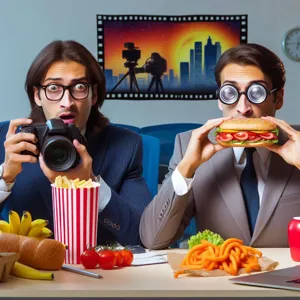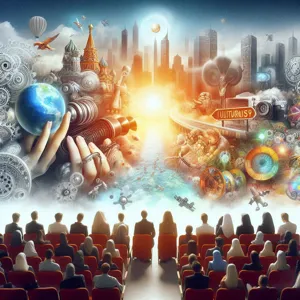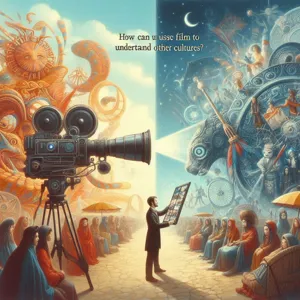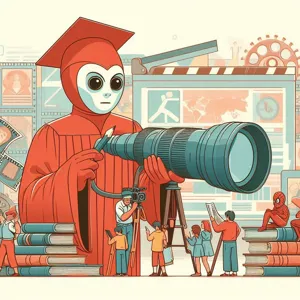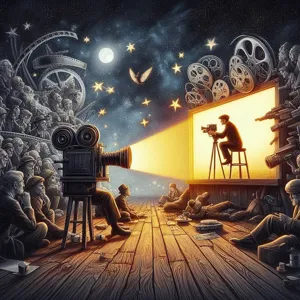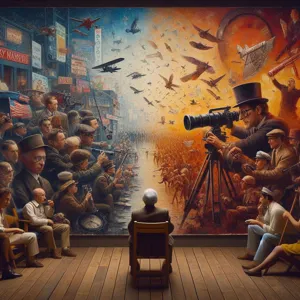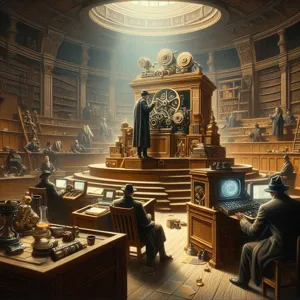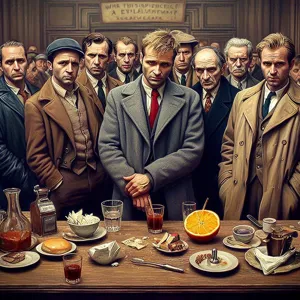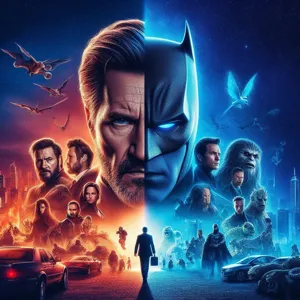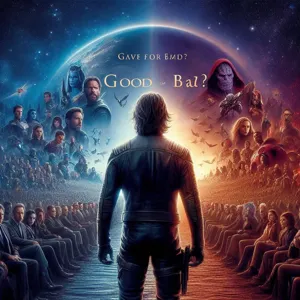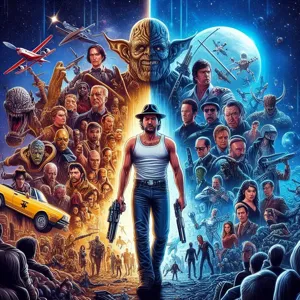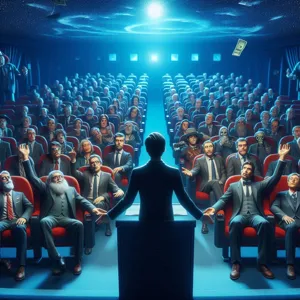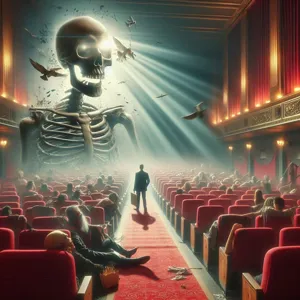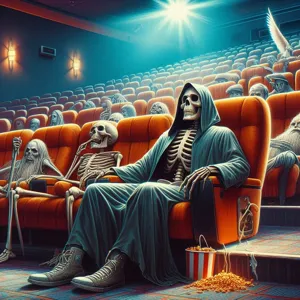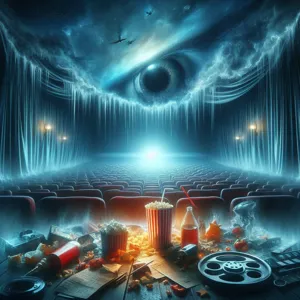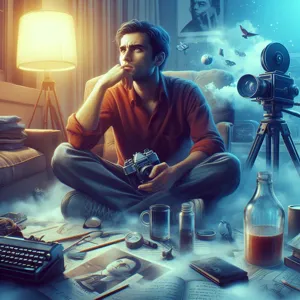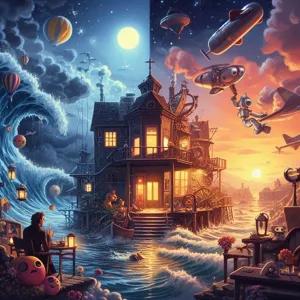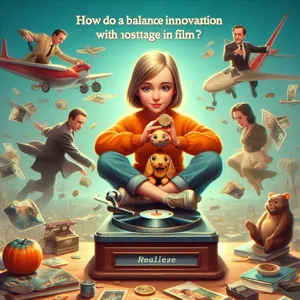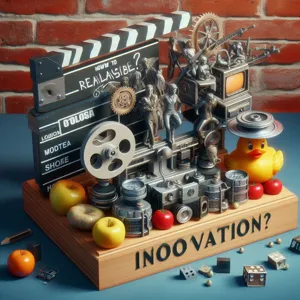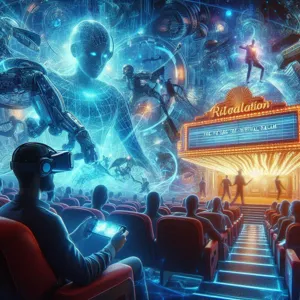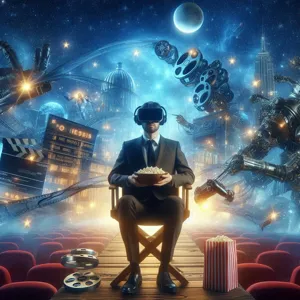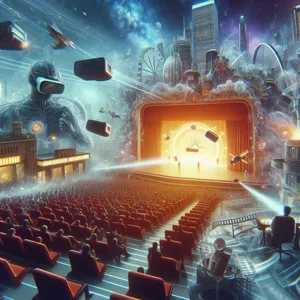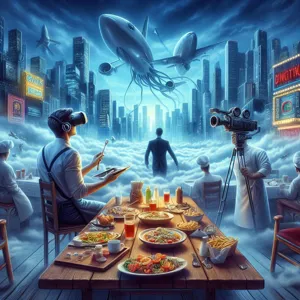As the lights dim and the screen flickers to life, the world of cinema has long served as a powerful mirror reflecting societal values, aspirations, and challenges.
Yet, behind the glamour of red carpets and box office hits lies a complex narrative of gender representation and equality that has evolved dramatically over the decades. In “Lights, Camera, Equality: Assessing Gender Progress in Cinema,” we delve into the strides made and the hurdles that remain in the quest for balanced representation on and off the screen. From the groundbreaking performances of trailblazing actresses to the rise of female directors and writers breaking through the glass ceiling, this blog post will explore the current landscape of gender in film, examining key moments, influential movements, and the ongoing dialogue surrounding inclusivity in storytelling. Join us as we shine a light on the progress made, celebrate the voices that have emerged, and reflect on the work still needed to ensure that every story—regardless of gender—has its rightful place in the cinematic spotlight.
1. Introduction: The State of Gender Equality in Cinema

The film industry has long been a mirror reflecting the societal norms and biases of its time. As we step into an era of heightened awareness regarding gender equality, the cinematic landscape is undergoing a critical transformation. Despite significant progress in recent years, the state of gender equality in cinema remains a complex and multifaceted issue.
Historically, women have been underrepresented both in front of and behind the camera, with a staggering disparity in the roles available to them and the recognition they receive. Statistics continue to reveal a disheartening trend: women filmmakers are still far outnumbered by their male counterparts, and leading roles often skew heavily towards male characters. While recent movements such as #MeToo and Time’s Up have sparked vital conversations and prompted many in the industry to reassess their practices, the path to true equality is still fraught with challenges.
In this blog post, we will explore the strides made towards gender equality in cinema, examining the impact of advocacy groups, industry initiatives, and landmark films that have challenged the status quo. We will also shine a light on the ongoing disparities that persist, delving into the stories of talented women whose contributions have often been overlooked. By assessing the current state of gender equality in cinema, we can better understand the work that still lies ahead and the collective responsibility we share in shaping a more inclusive future for the film industry.
2. Historical Context: Women in Film Through the Decades
To fully appreciate the strides made in gender equality within the film industry, it’s essential to examine the historical context that has shaped the roles of women in cinema over the decades. The journey of women in film is a tapestry woven with both triumphs and challenges, reflecting broader societal attitudes and shifts regarding gender norms.
In the early days of cinema, women often occupied positions as actresses, relegated to stereotypical roles that emphasized their beauty and domesticity. The silent film era showcased female stars like Mary Pickford and Lillian Gish, who, despite their immense talent, were frequently typecast and struggled for creative control. The transition to sound in the late 1920s brought new opportunities, yet it also solidified the industry’s patriarchal structures, with male directors and producers dominating the landscape.
The 1940s and 1950s heralded the Golden Age of Hollywood, where glamorous leading ladies shone brightly on screen. However, behind the camera, women remained largely absent from key creative roles. The emergence of film noir presented complex female characters, yet these roles often served to reinforce gender stereotypes rather than dismantle them. It wasn’t until the feminist movements of the 1960s and 1970s that the narrative began to change, with increased calls for representation and equality.
The 1980s and 1990s saw the rise of more prominent female filmmakers, such as Penny Marshall and Nora Ephron, who pushed boundaries and injected fresh perspectives into mainstream cinema. The introduction of independent films created spaces for diverse voices, allowing women to tell their own stories. Yet, despite these advancements, the industry remained plagued by issues such as unequal pay and limited opportunities for women of color.
As we entered the 21st century, the conversation around gender equality in film gained renewed momentum, fueled by movements like #MeToo and Time’s Up. The demand for authentic representation and inclusivity has led to increased scrutiny of hiring practices and a push for female-led projects. Initiatives aimed at mentoring and supporting women in the industry are on the rise, setting the stage for a more equitable future.
Understanding this historical context allows us to appreciate the progress made while recognizing the work that still lies ahead. As we continue to assess gender progress in cinema, it’s clear that the fight for equality is an ongoing narrative—one that requires vigilance, advocacy, and a commitment to amplifying women’s voices both on and off the screen.
3. Key Milestones: Pioneering Female Filmmakers

The journey toward gender equality in cinema has been shaped by a series of groundbreaking milestones, largely influenced by pioneering female filmmakers who dared to challenge the status quo. These trailblazers opened doors for future generations, proving that women’s perspectives are not only valid but essential to the tapestry of storytelling in film.
One of the earliest and most notable figures is Alice Guy-Blaché, who, in the late 19th and early 20th centuries, became the first female filmmaker in history. Her innovative work at Gaumont in France included early narrative films that showcased a woman’s ability to craft compelling stories, laying the groundwork for future female directors. Fast forward to the 1970s, and we see the emergence of directors like Lina Wertmüller, who became the first woman to receive an Academy Award nomination for Best Director with her film “Seven Beauties.” Her bold narratives and unique style challenged societal norms and showcased female strength in uncharted ways.
The 1990s heralded a new wave of female filmmakers, with names like Jane Campion and Sofia Coppola carving their niches in a male-dominated industry. Campion’s “The Piano” not only won the Palme d’Or at Cannes but also earned her an Academy Award for Best Original Screenplay, marking a significant moment in recognizing female talent on the global stage. Meanwhile, Coppola’s “Lost in Translation” highlighted the emotional intricacies of human relationships through a female lens, earning her an Oscar for Best Original Screenplay as well.
As we moved into the 21st century, the landscape continued to evolve with the rise of directors like Greta Gerwig and Ava DuVernay. Gerwig’s “Lady Bird” and DuVernay’s “Selma” not only garnered critical acclaim but also proved that films centered around female narratives can resonate deeply with audiences and critics alike, paving the way for more inclusive storytelling.
Each of these milestones represents not just a victory for individual filmmakers but a collective triumph for women in cinema. They remind us that while significant progress has been made, the journey is ongoing. The momentum created by these pioneers inspires a new generation of female filmmakers who continue to push boundaries, challenge stereotypes, and elevate women’s voices in the film industry, ensuring that equality and representation remain at the forefront of cinematic storytelling.
4. Representation Matters: Analyzing Gender Representation on Screen
Gender representation in cinema extends far beyond the mere presence of women or diverse identities on screen; it encompasses the depth, complexity, and authenticity of the characters portrayed. When we analyze gender representation, we must ask ourselves not just how many women are in a film, but what roles they occupy and how their stories are told. Are they multidimensional characters with their own arcs, or are they relegated to supporting roles that serve primarily to advance male narratives?
Studies have shown that films featuring strong female leads tend not only to perform well at the box office but also to resonate more deeply with audiences across various demographics. This shift is crucial; it allows for a richer tapestry of human experience that reflects the world we live in, which is diverse and multifaceted. However, while we celebrate progress, it’s essential to scrutinize the underlying stereotypes that often persist. Women of different backgrounds, such as women of color, LGBTQ+ individuals, and those with disabilities, frequently find themselves underrepresented or misrepresented, revealing a complex web of ongoing inequities.
Moreover, the impact of representation extends beyond mere visual presence. Characters are often shaped by the narratives created around them. Films that prioritize authentic storytelling—those that include input from women and underrepresented groups in writers’ rooms, directing chairs, and production teams—tend to create more impactful and relatable stories. This authenticity not only enriches the film itself but also empowers audiences, particularly young viewers, who look to the screen for reflections of their own lives and aspirations.
In the ongoing conversation about gender in cinema, it is vital to critique not only who is represented but how they are represented. By demanding more nuanced depictions of gender on screen, we advocate for a cinematic landscape that is inclusive, diverse, and reflective of the myriad experiences that exist in our society. This journey toward equitable representation is not just a goal—it’s an essential movement that can redefine storytelling in powerful ways.
5. Behind the Camera: The Role of Women in Film Production

Behind the Camera: The Role of Women in Film Production
As the film industry continues to evolve, one of the most significant shifts has been the increasing recognition of women’s contributions behind the camera. Traditionally, the roles of directors, producers, cinematographers, and editors have been predominantly male-dominated, often sidelining female talent and perspectives. However, a growing movement is actively challenging this status quo, highlighting the essential role women play in shaping cinematic narratives.
In recent years, the number of women taking on key production roles has steadily increased, bringing fresh voices and diverse viewpoints to the forefront of filmmaking. This change is not just about representation; it directly influences the stories that are told on screen. Women bring unique experiences and perspectives that can profoundly impact character development, plotlines, and overall storytelling. For instance, films directed by women often delve into themes of empowerment, resilience, and emotional depth in ways that resonate with audiences across various demographics.
Organizations and initiatives aimed at supporting female filmmakers, such as the Women’s Media Center and the Geena Davis Institute on Gender in Media, have gained traction, providing resources, mentorship, and funding opportunities specifically for women in the industry. These efforts are crucial in helping to dismantle the barriers that have historically kept women from thriving in film production roles.
Moreover, the success of female-led films at major festivals and award shows serves as a testament to the impact of women’s contributions behind the camera. Films such as “Lady Bird,” directed by Greta Gerwig, and “Nomadland,” directed by Chloé Zhao, not only achieved critical acclaim but also redefined expectations for storytelling in cinema. Their achievements are inspiring a new generation of female filmmakers to pursue their creative aspirations and challenge industry norms.
Yet, while progress is evident, the journey toward true equality in film production is far from over. Women still face significant challenges, including access to funding, networking opportunities, and representation in executive positions. By continuing to advocate for change and support female talent, the industry can ensure that the voices of women are not only heard but celebrated, ultimately leading to richer, more inclusive cinema for all.
6. Pay Disparities: The Gender Wage Gap in Hollywood
When we delve into the intricate fabric of Hollywood, one glaring thread stands out: the persistent gender wage gap that continues to plague the industry. Despite advancements in gender equality and the increasing visibility of female-led films, the stark reality is that women, particularly actresses, are often paid significantly less than their male counterparts for similar roles. Statistics reveal that, on average, women earn only 75 cents for every dollar earned by men in the same positions, a discrepancy that raises important questions about value, recognition, and equity in an industry that prides itself on storytelling.
This pay disparity is not merely a reflection of individual contracts but is indicative of a broader systemic issue within the industry. Female actors, even those with established careers and proven box office draws, frequently find themselves negotiating for salaries that are substantially lower than those offered to male stars, regardless of their experience, talent, or audience pull. High-profile examples abound, from the infamous pay gap between co-stars on major blockbuster films to the struggles faced by actresses in lower-budget productions who are often relegated to supporting roles with minimal compensation.
Moreover, the implications of these wage disparities extend beyond individual salaries; they shape the narratives that are told on screen. The lack of financial investment in female talent not only affects the livelihoods of actresses but also influences the types of stories that are prioritized in filmmaking. When financial backing skews heavily towards male-led projects, it ultimately narrows the scope of representation in cinema, limiting the diversity of voices and perspectives that reach audiences.
As we assess the strides made towards gender equality in Hollywood, it is crucial to confront the uncomfortable reality of pay disparities head-on. Advocacy for equitable pay and the dismantling of outdated norms is essential for fostering a more inclusive and representative industry. By holding studios accountable and demanding transparency in pay practices, we can work towards a future where talent is rewarded fairly, regardless of gender, allowing for a richer tapestry of stories that resonate with all audiences.
7. Intersectionality in Film: Addressing Race, Gender, and Identity
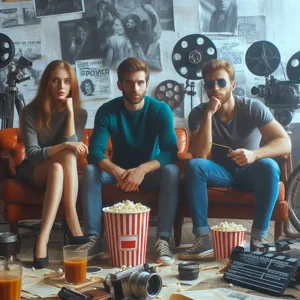
In recent years, the conversation around intersectionality in film has gained significant momentum, shining a much-needed light on the intricate ways in which race, gender, and identity intersect to shape the experiences of individuals both in front of and behind the camera. This nuanced perspective challenges the traditional narratives that often center around a singular identity, urging filmmakers and audiences alike to consider the multifaceted realities that characterize our society.
When we discuss intersectionality in cinema, we are not just addressing the representation of women or people of color in isolation; we are examining how these identities converge and influence one another. For instance, films that feature Black women or LGBTQ+ individuals often present unique challenges and experiences that differ from those faced by their male or cisgender counterparts. Such complexities are crucial in crafting authentic and resonant narratives that reflect the diversity of human experience.
Moreover, as the demand for diverse storytelling increases, filmmakers are beginning to embrace this intersectional approach in their projects. Movies like “Moonlight,” which delves into the life of a young Black man grappling with his identity and sexuality, exemplify how powerful intersectional narratives can be. They not only enrich the cinematic landscape but also foster empathy and understanding among viewers from various backgrounds.
However, the journey towards achieving true intersectionality in film is far from complete. The industry still grapples with systemic barriers that hinder the representation of marginalized voices. From hiring practices to funding opportunities, it is essential for studios and production companies to prioritize inclusivity at every level. By amplifying the voices of those who have historically been sidelined, the film industry can create a more equitable environment that reflects the rich tapestry of society.
As audiences, we hold the power to demand more intersectional representation in the films we support. By actively seeking out and celebrating stories that reflect diverse identities, we can contribute to a cultural shift that recognizes and values every individual’s unique narrative. The journey towards equality in cinema is ongoing, but by championing intersectional storytelling, we can pave the way for a more inclusive and representative future on the silver screen.
8. The Impact of Film Festivals on Gender Equality
Film festivals have long been a vital platform for showcasing diverse voices and narratives, but their role in promoting gender equality in the cinematic landscape cannot be overstated. These festivals serve as influential arenas where filmmakers, critics, and audiences converge to celebrate creativity while also highlighting pressing social issues, including gender disparity in the industry.
From the prestigious Cannes to the innovative Sundance, film festivals have increasingly prioritized gender equality in their programming and initiatives. Many now feature dedicated sections that spotlight female filmmakers and stories centered around women’s experiences. This not only helps to elevate the visibility of underrepresented voices but also challenges the traditional narratives often seen in mainstream cinema. By directly addressing the imbalance of gender representation behind and in front of the camera, these festivals are actively contributing to a shift in the industry’s culture.
Furthermore, film festivals often host panels and discussions that delve into the challenges faced by women in film. These conversations create a space for sharing experiences, strategies, and solutions, empowering attendees to advocate for change within their own circles. The networking opportunities available at these gatherings can also lead to collaborations that might not have occurred otherwise, fostering an environment where women can support one another and grow their careers.
The impact of awards at these festivals cannot be overlooked either. When female-led films receive accolades, it sends a powerful message to studios and investors about the viability of diverse storytelling. This recognition can lead to increased funding and opportunities for female filmmakers, ultimately reshaping the industry’s landscape over time.
In essence, film festivals are not just about the films that play on their screens; they are catalysts for change in the ongoing fight for gender equality in cinema. By championing female voices and facilitating vital conversations, these events play a crucial role in paving the way for a more inclusive and representative film industry. As audiences and critics alike become more aware of these efforts, the hope is that the momentum will continue to build, inspiring future generations of filmmakers to break barriers and tell their stories.
9. Case Studies: Successful Female-Led Films and Their Influence
In recent years, the cinematic landscape has witnessed a remarkable shift, with an increasing number of female-led films not only achieving commercial success but also sparking critical conversations around gender equality in the industry. These case studies delve into the stories behind some of the most successful female-led films, illuminating their impact on audiences and their significance within the broader context of gender representation in cinema.
Take, for example, *Wonder Woman* (2017), directed by Patty Jenkins. This groundbreaking film not only redefined the superhero genre but also broke box office records, grossing over $800 million worldwide. By centering on a powerful female protagonist, *Wonder Woman* challenged the long-standing notion that superhero films must be male-dominated. Its success paved the way for more female-led narratives in a genre traditionally reserved for male heroes, proving that audiences are eager for diverse storytelling.
Similarly, *Little Women* (2019), directed by Greta Gerwig, showcased the lives of four sisters navigating their aspirations and relationships in 19th-century America. With its critical acclaim and robust box office performance, the film highlighted the importance of female camaraderie and ambition. Gerwig’s adaptation not only resonated with audiences but also garnered six Academy Award nominations, further affirming the viability and necessity of female-centered narratives in mainstream cinema.
In the realm of animated features, *Frozen* (2013) stands out as a cultural phenomenon. The film, featuring two strong female leads, Elsa and Anna, became a worldwide sensation, earning over $1.28 billion at the box office. Its themes of sisterhood, empowerment, and self-acceptance resonated deeply with viewers, particularly young girls, igniting discussions about the portrayal of women in animated films and the importance of role models.
These examples underscore a pivotal trend: female-led films are not just commercially viable but also influential in shaping societal perceptions of gender roles. As these films continue to thrive, they inspire future generations of filmmakers and storytellers to push boundaries and create more inclusive narratives, ultimately contributing to a more equitable cinematic landscape. By examining the successes of these films, we can better understand the transformative potential of female representation in the arts and the ongoing journey toward gender equality in Hollywood and beyond.
10. Critiques of Current Representation: What’s Still Missing?
As the dust settles on the accolades and applause of award seasons, a critical lens remains focused on the representation of gender in cinema. While there have been notable strides toward gender equality in recent years—more female directors helming blockbuster films and an increasing number of complex, nuanced female characters—there is still much work to be done. The landscape of modern cinema, despite its advancements, continues to exhibit significant gaps in authentic representation.
One of the most glaring issues is the underrepresentation of women from diverse backgrounds. While mainstream narratives often prioritize white, cisgender female characters, the stories of women of color, LGBTQ+ individuals, and those with disabilities remain largely sidelined. This lack of inclusivity not only limits the richness of storytelling but also perpetuates stereotypes that are harmful and reductive. Audiences crave authenticity; they want to see their own experiences reflected on screen, yet many marginalized voices are still waiting for their moment in the spotlight.
Additionally, the portrayal of women in film often falls into predictable tropes—be it the “damsel in distress,” the “femme fatale,” or the “strong woman” archetype. Such characterizations can dilute the complexity and diversity of female experiences. The need for multifaceted, relatable characters who defy conventional roles is paramount, as it fosters a deeper understanding of women’s realities and challenges.
Furthermore, the power dynamics behind the camera require scrutiny. Although female directors and writers are gaining more visibility, the industry still predominantly operates under male leadership. This disparity affects the narratives that are prioritized and the types of stories that are told. Gender equality in cinema isn’t just about the roles women play; it’s also about who gets to tell those stories.
In summary, while there have been significant advancements in gender representation within the film industry, critiques of current representation highlight the pressing need for broader inclusion and richer character development. As audiences continue to advocate for change, the conversation must expand beyond mere statistics to encompass the depth and breadth of female experiences, ensuring that all voices are heard and valued in the cinematic landscape. Addressing these gaps is essential not just for equity but for the evolution of storytelling itself, leading to a more vibrant and representative future for cinema.
11. The Role of Social Media in Advocating for Change
In the digital age, social media has emerged as a powerful platform for advocating change and amplifying voices that were once marginalized in the cinematic landscape. From Twitter threads that dissect the gender dynamics of a new film release to Instagram campaigns showcasing female filmmakers and their contributions, social media serves as both a megaphone and a mobilization tool for gender equality in cinema.
Hashtags like #TimesUp and #MeToo have not only sparked global conversations about harassment and discrimination within the industry but have also created a sense of community among advocates pushing for systemic change. These movements encourage individuals to share their stories, leading to greater awareness and urgency for addressing gender disparities.
Moreover, social media allows for immediate feedback and dialogue, enabling audiences to hold studios and production companies accountable for their practices. A single viral post can lead to widespread scrutiny of a film’s casting choices, crew diversity, or the portrayal of female characters. This level of public engagement pressures filmmakers to reconsider their narratives and the teams behind them, ultimately fostering a culture of inclusivity and representation.
Additionally, platforms like YouTube and TikTok have enabled aspiring filmmakers and critics to showcase their talents, perspectives, and critiques, further diversifying the voices in cinema. This democratization of content creation allows for a broader array of stories to be told—ones that resonate with audiences who have long been underrepresented on screen.
In essence, social media is not just a tool for communication; it is a catalyst for change, inspiring a new generation of filmmakers and audiences alike to advocate for a more equitable cinematic landscape. As the conversation continues to evolve, it will be crucial for the industry to listen, adapt, and embrace the insights offered through these digital dialogues.
12. Future Trends: Emerging Female Voices in Cinema
As we look towards the horizon of cinema, an exciting wave of emerging female voices is set to reshape the industry landscape. The past few years have witnessed a seismic shift in who gets to tell stories, with a growing number of women directors, screenwriters, and producers stepping into the limelight. These creators are not only diversifying the narratives we see on screen but also challenging the status quo, bringing fresh perspectives that reflect the complexities of modern society.
One noteworthy trend is the rise of intersectional storytelling. Filmmakers like Lulu Wang, who garnered acclaim for *The Farewell*, and Chloé Zhao, whose work on *Nomadland* earned her an Academy Award, are crafting narratives that explore the rich tapestry of experiences shaped by race, culture, and gender. This shift towards inclusivity is not merely a trend but a necessary evolution in cinema that resonates with audiences craving authenticity and representation.
Moreover, streaming platforms have become a powerful ally in amplifying these emerging voices. The democratization of content distribution allows for a broader range of stories to find their audience, breaking through the traditional barriers of Hollywood. Female filmmakers are seizing this opportunity to share their unique visions, whether through intimate dramas, bold comedies, or groundbreaking documentaries.
In addition to storytelling, the industry is also seeing a surge in initiatives aimed at fostering female talent. Programs focused on mentorship, funding, and training for women in film are becoming more prevalent, helping to cultivate the next generation of female storytellers. Organizations like Women in Film and initiatives such as the Sundance Institute’s Women’s Initiative are pivotal in supporting this shift, ensuring that the voices of women are not just heard but celebrated.
As we venture into this new era of cinema, the emergence of female voices promises to enrich the storytelling landscape. These creators are poised to confront societal issues, inspire change, and tell the stories that have been overlooked for far too long. The future of cinema is bright, and it’s illuminated by the diverse narratives being shaped by women who are ready to take center stage.
13. How Audiences Can Support Gender Equality in Film
As audiences, we wield tremendous power in shaping the film industry through our choices and actions. Supporting gender equality in cinema goes beyond merely enjoying films; it involves being active participants in the conversation around representation and inclusivity. Here are some impactful ways you can contribute to this vital cause:
1. **Choose to Watch Films with Diverse Voices**: Make a conscious effort to seek out and support films created by women and marginalized groups. By purchasing tickets to these films or streaming them on various platforms, you not only help boost their visibility but also send a strong message to studios about the demand for diverse storytelling.
2. **Engage in Conversations**: Use your voice to discuss gender representation in film with friends, family, and on social media. Share reviews and recommendations of films that challenge traditional narratives and highlight female perspectives. The more we talk about these issues, the more awareness we create, encouraging others to join the movement.
3. **Support Female Filmmakers and Creatives**: Follow and promote female directors, writers, producers, and actors. Attend film festivals that showcase women-led projects, and consider supporting crowdfunding initiatives for female-driven films. Your support can help amplify their work and ensure these voices are heard.
4. **Advocate for Change**: Utilize your platforms to advocate for gender equality in the film industry. Sign petitions, join organizations focused on this cause, and participate in campaigns that aim to hold studios accountable for their hiring practices and storytelling choices.
5. **Educate Yourself and Others**: Stay informed about the current state of gender representation in cinema. Read articles, watch documentaries, and engage with research that highlights the disparities in the industry. By educating yourself and others, you help foster a more informed audience that can recognize and challenge inequality.
By actively participating in these efforts, audiences can play a crucial role in fostering a more equitable film landscape. Each ticket purchased, story shared, and conversation sparked contributes to a greater movement towards gender equality in cinema. Together, we can help ensure that diverse voices are not only heard but celebrated on the big screen.
14. Conclusion: The Path Forward for Gender Equality in Cinema
As we draw this exploration of gender progress in cinema to a close, it is evident that while significant strides have been made, the path toward true gender equality in the film industry remains long and winding. The landscape of cinema is continuously evolving, influenced by cultural shifts, societal demands, and the tireless advocacy of those who champion inclusivity. However, the statistics and narratives we’ve examined highlight the necessity for ongoing commitment and vigilance.
Moving forward, the emphasis must be placed not just on increasing the visibility of women in front of the camera but also on amplifying their voices behind the scenes. This includes fostering opportunities for women directors, writers, producers, and crew members, ensuring that diverse perspectives shape the stories we tell. Industry leaders must prioritize equitable hiring practices, provide mentorship programs, and create supportive environments that empower women at every stage of their careers.
Moreover, audiences play a crucial role in this evolution. By supporting films that prioritize gender equality, celebrating diverse storytelling, and advocating for change within the industry, viewers can help to shift the narrative. Engaging in conversations about representation and equity, both online and offline, is vital in holding studios accountable and demanding better from content creators.
As we look to the future, let us carry the lessons learned from both the progress and setbacks of the past. By committing to a collective effort—one that encompasses filmmakers, industry stakeholders, audiences, and advocates—we can pave the way for a more equitable cinematic landscape. In doing so, we not only enrich the storytelling tapestry of cinema but also contribute to a broader cultural transformation that values and uplifts every voice. The journey toward gender equality in cinema is not just a goal; it is an ongoing movement that requires our unwavering dedication and passion.
15. Resources and Organizations Advocating for Change in the Industry
In the quest for greater gender equality in the film industry, numerous organizations and resources have emerged, championing the cause and providing vital support to those seeking to enact change. These organizations not only raise awareness about gender disparities in cinema but also offer tools, funding, and networks to empower underrepresented voices.
One prominent organization is **Women in Film**, which advocates for gender parity in the film and television industries. They offer mentorship programs, grants, and educational workshops aimed at fostering female talent both in front of and behind the camera. Their annual awards celebrate the achievements of women in the industry, shining a light on the barriers they have overcome and inspiring the next generation of filmmakers.
Another key player is the **Geena Davis Institute on Gender in Media**, founded by the acclaimed actress Geena Davis. This organization conducts groundbreaking research on gender representation in film and television, providing valuable insights into the impact of onscreen portrayals. By partnering with various studios and networks, they strive to influence media creators to make informed decisions that promote gender equality.
Additionally, the **Sundance Institute** plays a crucial role in supporting diverse voices through its labs and fellowships. They focus on nurturing projects created by women and underrepresented groups, ensuring that their stories are told and valued in the cinematic landscape.
On a grassroots level, organizations like **The Representation Project** mobilize communities to challenge gender stereotypes through film and media literacy. They develop educational materials that help audiences critically engage with media representations, fostering a culture of awareness and advocacy.
Social media campaigns, such as **#TimesUp** and **#MeToo**, have also galvanized support for gender equity in cinema, promoting accountability and encouraging open dialogue about the challenges faced by women in the industry.
By engaging with these resources and organizations, individuals and filmmakers can join the movement toward a more equitable and inclusive film industry. Whether through collaboration, funding, or advocacy, these groups are vital in shaping a future where diverse voices are not just heard, but celebrated on the big screen. As we assess gender progress in cinema, it is clear that the collective efforts of these organizations are instrumental in driving meaningful change.
As we conclude our exploration of gender progress in cinema, it’s clear that while strides have been made, there remains much work to be done. The film industry, a powerful cultural mirror, reflects societal attitudes and influences perceptions of gender roles. By assessing the challenges and triumphs detailed in this post, we are reminded of the importance of advocacy for equal representation both in front of and behind the camera. As audiences, we can champion films that tell diverse stories and support creators who strive for authenticity and inclusivity. Together, let’s continue to shine a spotlight on the ongoing journey toward equality in cinema, ensuring that future generations not only witness progress but also contribute to a more equitable storytelling landscape. Your voice matters—so let it be heard in the choices you make as a viewer and a supporter of the arts.




